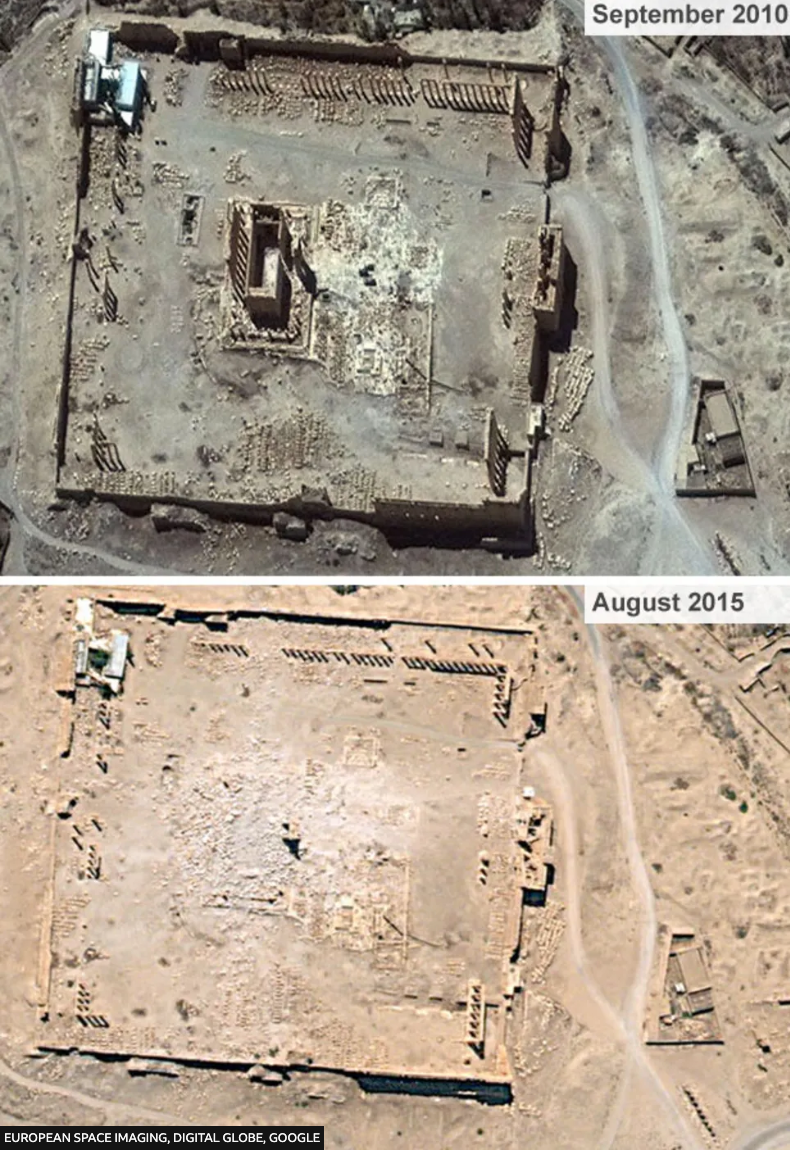
The Temple of Bel stands in the ancient Syrian city of Palmyra, adjoining a desert oasis with palm trees and bountiful water. In 2015, the temple was destroyed by ISIS explosives. Here is the before and after photos.
We visited Palmyra 20 years ago. Its pillars preserved standing tall in the middle of the desert and strangely out of place in Syria, a memory from another time when Romans were expanding their empire. Some say this ancient city would make Rome blush.
The Temple of Bel stands in the ancient Syrian city of Palmyra, adjoining a desert oasis with palm trees and bountiful water. Constructed in the first two centuries of the Common Era, the temple served for nearly two thousand years as a sanctuary for locals and as a site of significant archaeological interest. In 2015, the temple was destroyed by ISIS explosives. ISIS went on a blowing up rampage and destroyed whatever was in its way, such as Jonah’s Tomb.
Palmyra was the capital of an independent and far-reaching Roman-style empire, expanding its borders beyond Syria to Egypt and much of Asia Minor. Islamic jihads hated the idea that traces of ancient infidels should remain in Muslim countries.
In “The Future of the Temple of Bel in Palmyra after its Destruction,” a new paper from the Bulletin of the American Society of Overseas Research, authors Maamoun Abdulkarim and Jacques Seigne argue for the urgent need to intervene in the restoration of the temple, and to facilitate the return of the Palmyrene population, in order to ensure this World Heritage site’s enduring existence.
The Temple of Bel was built on an ancient tell and consecrated to a Mesopotamian god. The central cella structure stands in a courtyard, surrounded by Corinthian columns. During the temple’s long history, the building was variously used as a church, and then a mosque, before being converted into a residential shelter, which was its function through the early 20th century.

Between 1920 and 1946, Syria and Lebanon were governed under the French mandate, and during this time, French authorities interested themselves in the preservation of Syria’s antiquities. The villagers of Palmyra were displaced from the Bel sanctuary into a settlement constructed nearby while the French administration cataloged and cleaned the temple site.
And although the residents of Palmyra returned to their home following the French archaeological mission, they would be forced to flee again in 2015 and 2016, during two occupations by ISIS. Once a population of some 40,000, by 2022, only 2,000 people had returned to the village inside the temple walls.
The bombs ISIS detonated in the summer of 2015 caused great damage to the Temple of Bel, but did not succeed in destroying the structure entirely. Specialists visiting the site after its 2016 liberation from the terrorist group were able to confirm that although the walls of the cella had collapsed, along with columns of the surrounding porticos, a large western gate and the foundations of the temple walls remained intact.
Nevertheless, write Abdulkarim and Seigne, the structure’s devastation disastrously impacted not only the site itself but also the lives of the citizens surrounding it. The return of the Palmyra community is crucial, the article authors write, “not only because they are a source of labor and practical expertise, but also due to their collective memory and ownership of the site. They are a part of its story.”
The story of the Temple of Bel is long and complex, including not just its origins in the age of the Roman Empire and its archaeological significance to visitors from across the world, but even, the authors note, its catastrophic bombing at the hands of extremists. The marks of destruction, they write, “are only another stage in the life of an exceptional, unique monument.”
Yet despite this context, preservation, continue Abdulkarim and Seigne, is ultimately paramount. The site in its current state could pose dangers to those that visit it. Furthermore, the Temple of Bel’s place in the history of Syria must be stabilized. They add, “Palmyra has witnessed the worst of times—the authors’ plea is for global cooperation and a shared ambition to protect the Temple of Bel, ensuring the return of a far more positive narrative.”
My experience in Syria is that nothing was being protected or preserved by western standards. Visitors had no supervision at archaeological sites, payment was a couple of dollars to explore, and locals often tried to give us or sell artifacts looted from the rubble and monuments. Meanwhile, Syria is building its economy on a drug trade, Captagon. The archaeology that they overtook when Arabs moved to Palmyra should be preserved as a legacy of all Middle Eastern heritage.
Comments






